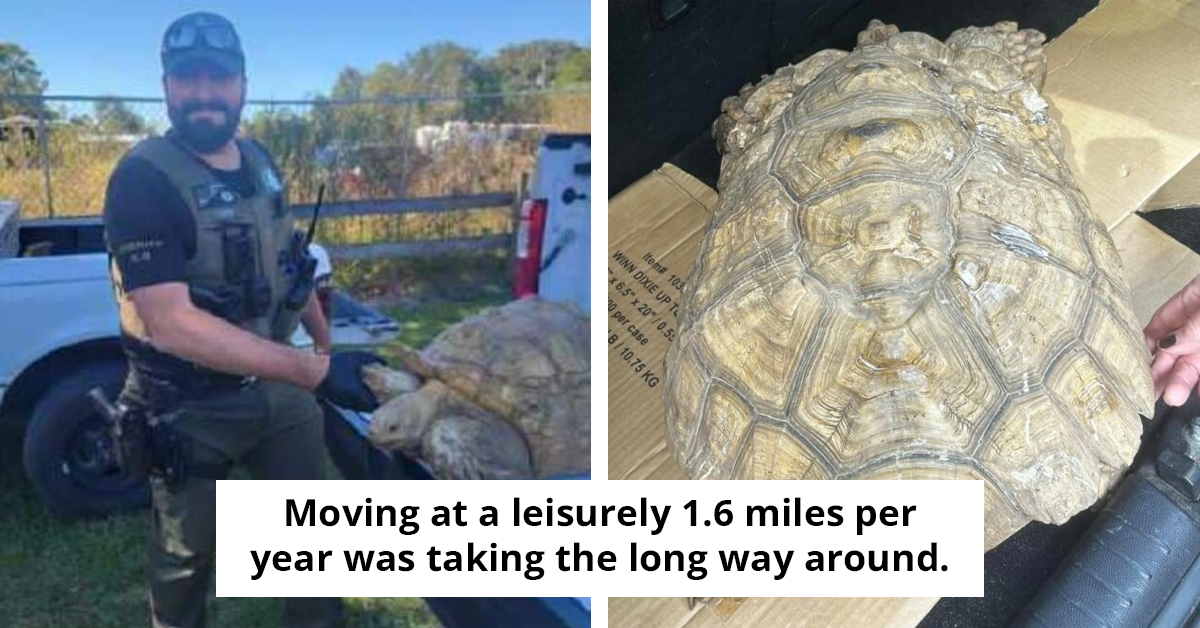Redditor Whose Dog Pounces On Kids Wants To Know If Lying To A Little Girl About His Pet Being Aggressive Was The Wrong Move
When it comes to our furry friends, there are few things more heartwarming than seeing kids interact with them. However, when those interactions cross into unintended territories, such as kids encroaching on a dog's personal space without proper respect for boundaries, it can be quite the opposite.
Dogs may seem like simple creatures — and sometimes that simplicity can lead us to assume we know best when it comes to their behavior. If you truly want your kids to get along with dogs (and vice versa), teaching them why respecting a dog's boundaries is so important is key!
Sadly, some parents never teach their children the importance of respecting a dog's boundaries. When little ones know nothing about a dog's tendencies when strangers approach, they can get into trouble.
So it's no wonder why one Redditor tried a very quick solution to prevent a child from getting near his dog. That solution was lying.
A user named ThrowRAAggressiveDog didn't want to deal with the persistence of a kid in his neighborhood, so he told the little girl that his dog was aggressive.
However, when the girl saw the dog owner's brother playing with the dog, she complained that he was lying. Now, the little girl looks at him with disdain.
Since he's wondering if he was wrong, the dog owner asks the “Am I The A**hole?” (AITA) subreddit about the situation.
The original poster (OP) moved out of his family home with his dog.
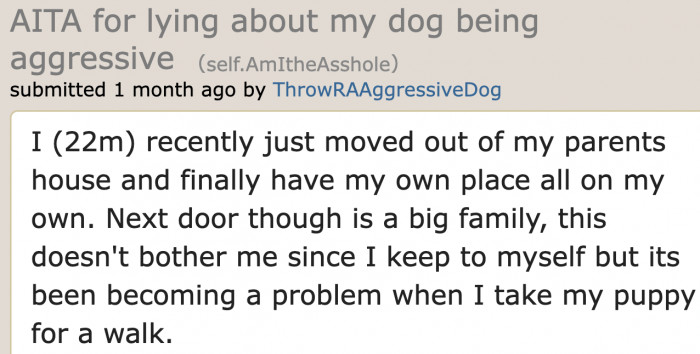
The dog is so large that it can knock kids down.

He keeps kids from getting near his dog.
But there's one kid who's persistent. So he lied, telling the little girl's mom that his dog is aggressive.
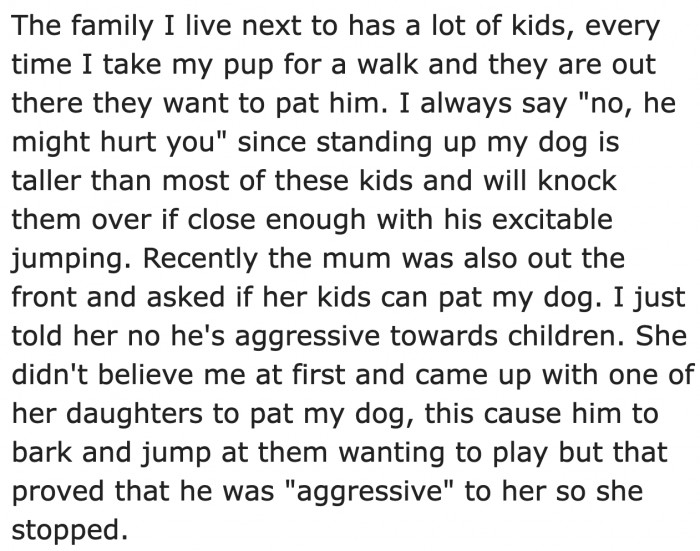
The Impact of Fear on Behavior
Dr. Lisa Monroe, a behavioral psychologist, explains that fear often drives people to make decisions that may seem irrational to others.
In this case, the owner's fear of the dog's potential aggression can lead to protective behavior, which is a natural response to perceived danger.
Research indicates that when individuals feel threatened, their decision-making can be heavily influenced by their emotional state, leading to choices that prioritize safety over social connection.
The Impact of Fear on Dog Behavior
Dr. Anna Mitchell, an animal behaviorist, highlights that fear plays a significant role in how dogs behave towards children and strangers.
Her research shows that when dogs feel threatened, they may react aggressively as a defense mechanism.
This situation raises important questions about how to protect both the dog and the child involved.
The girl found out that kids can play with it, after all.
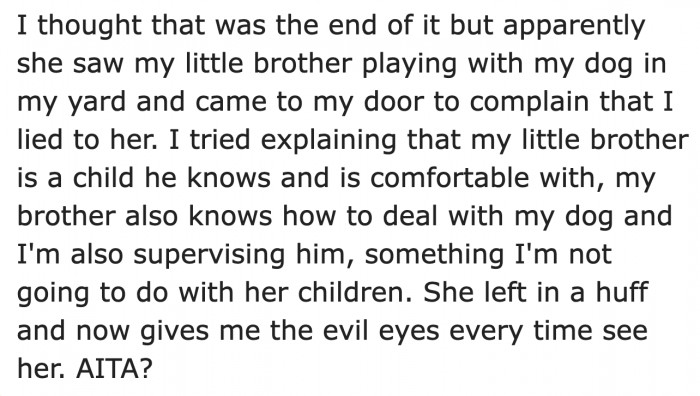
He only needed to refuse. Explanations aren't necessary.
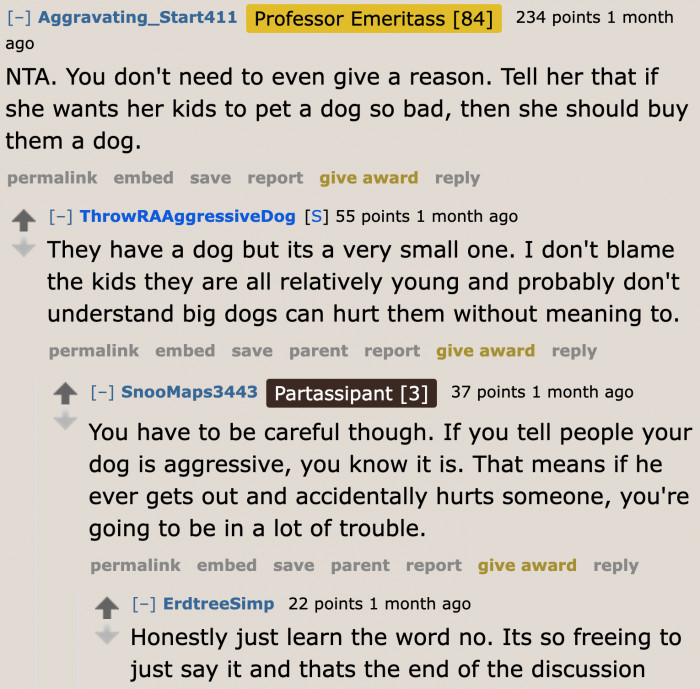
Even adults can get hurt by a playful dog.
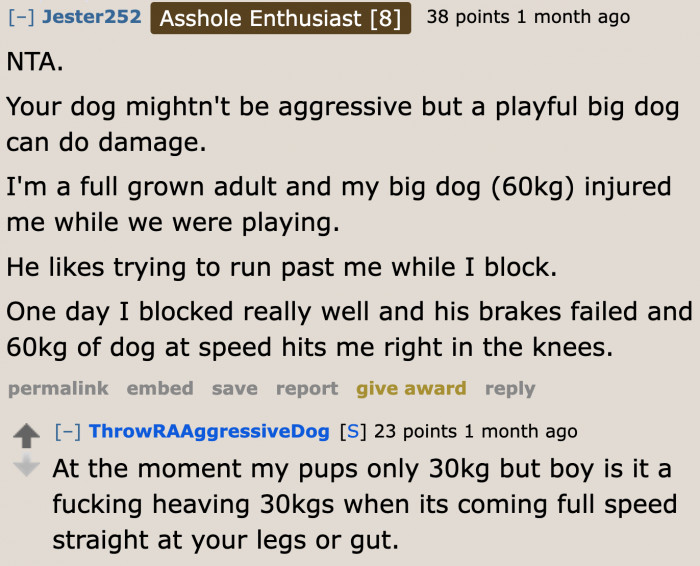
Attachment theory suggests that individuals with insecure attachments may exhibit heightened anxiety in social situations, influencing their perceptions of safety. According to Dr. Dan Siegel, a renowned child psychiatrist, "Children's early experiences with caregivers can significantly shape their emotional responses and fears." Furthermore, insights from Dr. Michael Thompson, a child psychologist, emphasize that "Past interactions with animals can create lasting impressions, leading to a cycle of behavior that is challenging to alter." Understanding these dynamics can help the owner navigate the situation more effectively.
Studies indicate that children are particularly vulnerable to dog-related incidents, often due to a lack of understanding of canine behavior.
According to research from the Journal of Animal Science, educating children about safe interactions with dogs can significantly reduce the risk of bites and injuries.
It's crucial for dog owners to take the initiative in training their pets and educating those around them.
A user believes that there's a better way to explain his dog's behavior to the little girl.
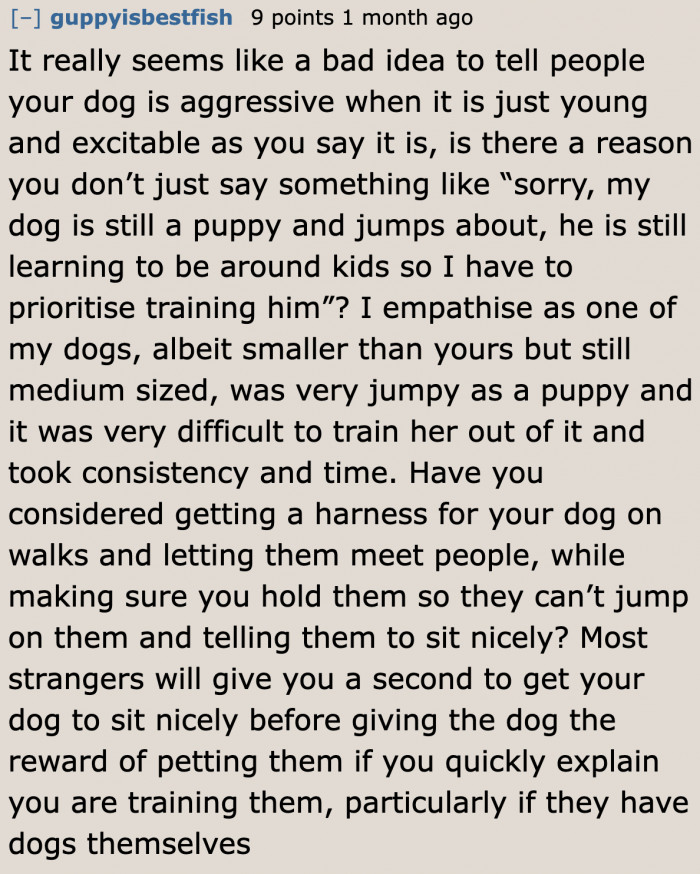
It's always the dog owners who get the blame when it's the kids who aren't respecting dogs' boundaries.
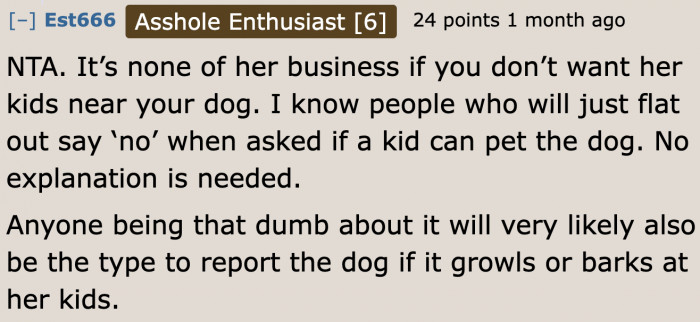
The mom should have respected the OP's decision.

Building Trust Through Communication
Effective communication is essential when navigating fear-based responses, particularly in community settings.
Research indicates that open dialogues about fears and expectations can foster understanding and reduce anxiety.
By discussing the dog's behavior and the precautions taken, the owner can alleviate concerns and build trust with neighbors.
Communication and Safety Measures
Effective communication between dog owners and the community is vital for ensuring safety.
Behavioral psychologists emphasize that establishing clear guidelines for interaction can help prevent misunderstandings and dangerous situations.
In this case, informing neighbors about the dog's temperament can foster a safer environment for everyone involved.
Entitled moms breed entitled children.
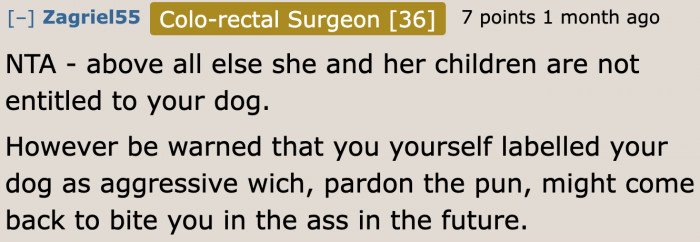
Both sides had their faults, according to this user.

More users disagreed with the OP's actions.
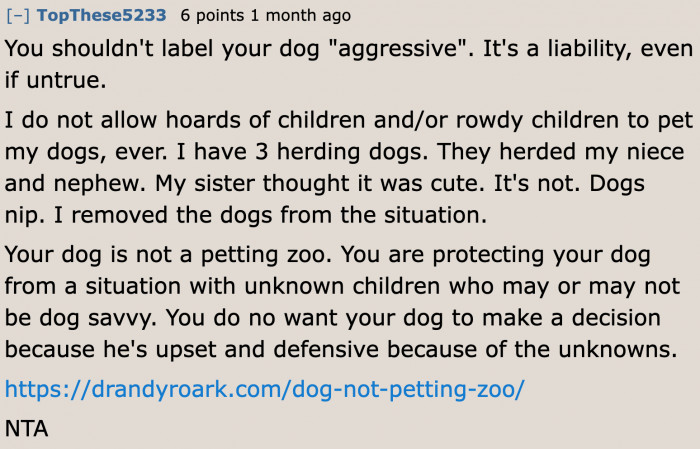
To address the situation constructively, the owner should consider engaging with neighbors to provide reassurance about the dog's training and behavior.
Sharing updates on progress or seeking community support can help create a more secure environment for everyone involved.
Additionally, involving a professional trainer to work with the dog can demonstrate a commitment to safety and responsible pet ownership.
Dog owners should consider implementing safety measures, such as using leashes or barriers when around children.
Research suggests that proactive training and socialization can significantly reduce fear-based aggression in dogs.
Additionally, consulting with a professional trainer can provide valuable insights into managing dog behavior effectively.
This user believes that OP did what's best.
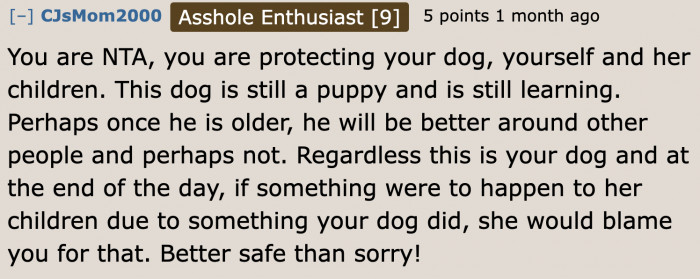
The dog being jumpy is just a phase.

"No" was enough as an answer. The mom is just entitled.
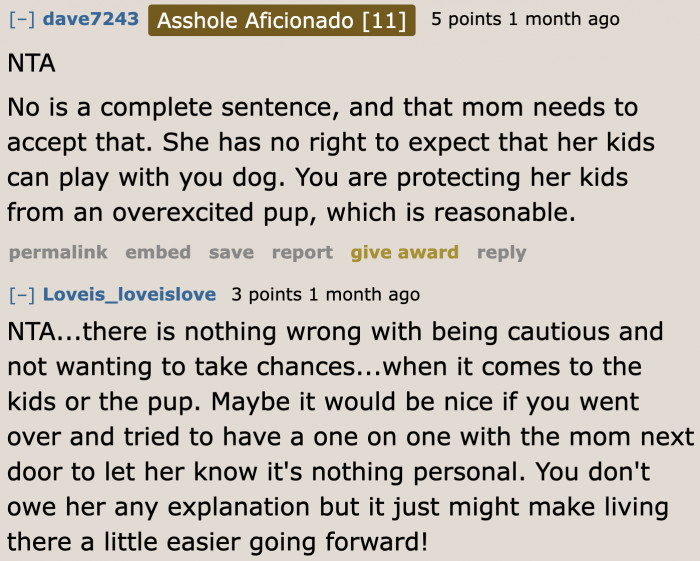
Encouraging Cooperative Solutions
Communities thrive on cooperation and understanding, especially when it comes to pet ownership.
By actively seeking input from neighbors about their concerns, the owner can create a collaborative approach to managing the dog's behavior.
Regular check-ins or community gatherings can help foster a sense of togetherness, turning potential conflicts into opportunities for building relationships.
The easy way out isn't always the best solution.

Neighbors could get the OP into trouble because of what he said.
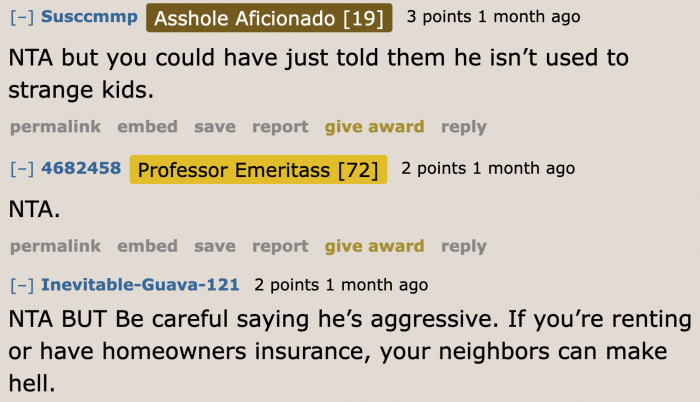
Even if the OP isn't the a-hole in this situation, he still needs to help his dog overcome the behavior.
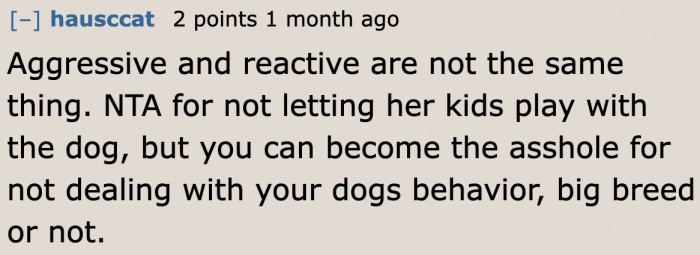
Neighbors should just listen to dog owners. No unnecessary drama is needed.
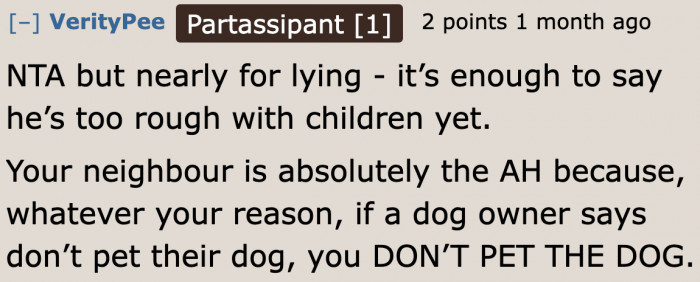
We think it's better to just ignore the pushy girl.

This woman is not entitled to anyone's dog.

While it's true that the OP shouldn't have labeled his dog as aggressive, the mother and her daughter were in the wrong as well. They should learn to respect a dog owner's decision.
Owners shouldn't use the term "aggressive" to describe their dog when it's not true, as it could get them in trouble with neighbors.
Psychological Analysis
This behavior reflects the complexities of managing interactions between dogs and children.
Understanding canine behavior and establishing safety measures is essential for fostering positive relationships in the community.
Analysis generated by AI
Analysis & Alternative Approaches
In summary, understanding the role of fear in dog behavior is essential for ensuring safety in dog ownership.
Research indicates that proactive measures, such as training and education, can significantly reduce the risk of aggressive incidents.
Ultimately, fostering clear communication and safety protocols can lead to healthier relationships between dog owners and their communities.
Analysis & Alternative Approaches
Fear can heavily influence behavior, leading individuals to make decisions that might seem irrational.
By fostering open communication and building trust, pet owners can navigate these challenges more effectively.
Ultimately, responsible pet ownership involves understanding both the animal's needs and the community's concerns, paving the way for harmonious relationships.
